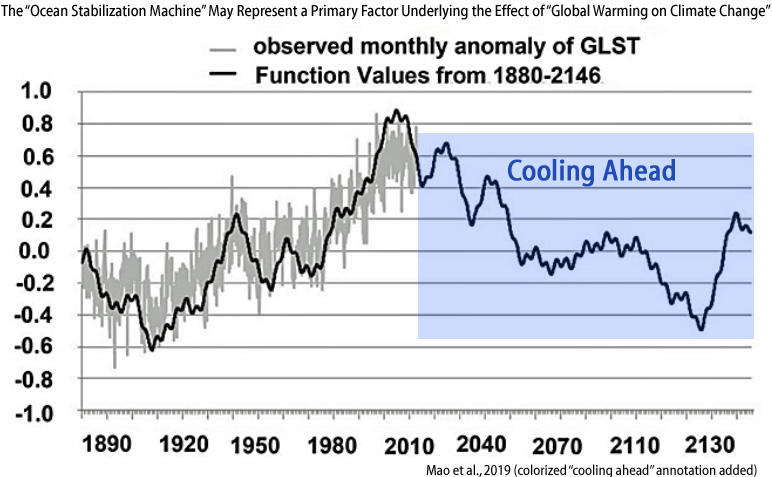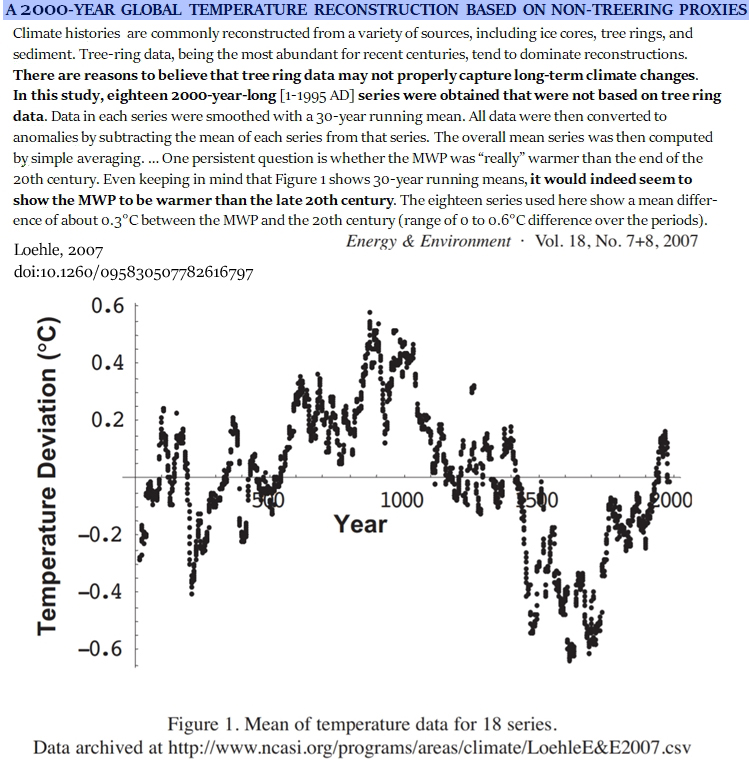New Paper: Modern Warming Was Driven By ‘Primarily Natural’ Factors. Global Cooling Has Now Begun
Four climate scientists assert (1) the last ~130 years of temperature changes fit “perfectly” into statistical indices of natural variation, and (2) a long-term deep cooling of the Earth system has recently commenced.

Image Source: Mao et al., 2019
An analysis published in the journal Atmospheric and Climate Sciences by 4 climate scientists reveals the 1880-2013 temperature changes fit “perfectly” (0.9 correlation) into a calculation utilizing 15,295 periodic functions of natural variation.
The authors claim this affirms that the non-anthropogenic “major climate factors” (i.e., solar-cloud and ENSO forcing) can still be considered the “main reason” driving modern warming (Lakshmi and Tiari, 2015; Hassan et al., 2016; McLean, 2014; Yeo and Kim, 2015; Wielicki et al., 2002; Douglass and Knox, 2014; Sejrup et al., 2010; Large and Yeager, 2012; Irvine, 2015; Cess and Udelhofen, 2003; Clark, 2010; Ogurtsov et al., 2017; Fleming, 2018; Zherebtsov et al., 2019).
Mao, Tan, Chen, and Fan (2019) effectively suggest we humans do not exert fundamental control over the Earth’s climate-modulating “Ocean Stabilization Machine”.
Consequently, their statistical analysis further indicates a global cooling trend has recently begun, and the overall decline in global temperature will precisely reach −0.6051˚C below the long-term average in the year 2111.
The “Ocean Stabilization Machine” May
Represent a Primary Factor Underlying the
Effect of “Global Warming on Climate Change”
• “Contemporary references to global warming pertain to the dramatic increase in monthly global land surface temperature (GLST) anomalies since 1976. In this paper, we argue that recent global warming is primarily a result of natural causes.”
• “Global climate changes are controlled by major periodic [natural] factors that represent basic principles in climatology, such as solar radiation, atmospheric circulation and oceans.”
• “A number of scientists subjectively consider that the recent dramatic upward trends in monthly GLST anomalies represent non-periodic and irreversible changes and postulate that warming related to the global greenhouse effect has primarily been caused by anthropogenic emissions. However, with the decline of global warming, an increasing number of scientists have started to question this view [Chen and Tung, 2014; Easterling and Wehner, 2009; Fyfe et al., 2013; Meehl et al., 2011; Risbey et al., 2014; Curry and Webster, 2011; Loehle, 2007; Lindzen, 2007; Holland, 2013; Seneviratne et al., 2014; Kosaka and Xie, 2014; England et al., 2014].”

Image Source: Loehle, 2007
• “There are two primary methods challenging the hypothesis that recent global warming is caused by anthropogenic emissions: the first method is to prove that the recent dramatic upward trend of monthly GLST anomalies is periodic, and the second method is to link global warming to major factors in nature.”
• “In this paper, we have found that the dramatic upward rising signals can be perfectly fitted with periodic functions, which suggests that the major climate factors can still be the main reason for the recent global climate warming, and the secondary climate factor such as anthropogenic emissions might be the secondary reason. … We have identified 15,295 periodic functions that perfectly fit the monthly GLST anomalies from 1880 to 2013 and show that the monthly SST anomalies in six domains in different oceans are highly correlated [0.9 coefficient] with the monthly GLST anomalies.”
• “If we use the best function to predict the future behaviour of GLST, we can know that the downward trend for the monthly anomaly of GLST had already begun, and it will reach −0.6051˚C in 2111.”
• “The correlation study tells us that the dramatic anomalies can be seen in SST fields of different oceans, which might be the results of OSM [“Ocean Stabilization Machine”], and with the k-line diagram technique, we can see that most of the annual dramatically increasing GLST anomalies occur in El Niño years; and most of the annual dramatically decreasing GLST anomalies occur in La Niña years. These findings show us how OSM works. In a word, although there are many academic topics need to study further in future, we can still make a conclusion: “OSM” might play a very important role to cause global climate changes.”

Image Source: Mao et al., 2019



